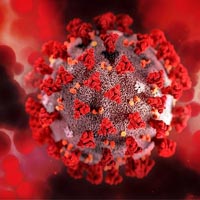Computed tomography severity scoring of COVID 19 infected young patients: Is the second wave affecting the young lungs more than the first wave in India?

Accepted: 22 November 2021
HTML: 12
All claims expressed in this article are solely those of the authors and do not necessarily represent those of their affiliated organizations, or those of the publisher, the editors and the reviewers. Any product that may be evaluated in this article or claim that may be made by its manufacturer is not guaranteed or endorsed by the publisher.
We evaluated the High Resolution Computed Tomography (HRCT) findings in young patients (< 40 years) infected with the COVID 19 virus and tried to find out any difference in the severity of lung involvement between the first and second wave of the pandemic and whether the notion of young population being more severely affected by the second wave holds true.Two-hundred (200) young patients (<40 years) with RT PCR documented COVID infections undergoing HRCT chest at our institute were included. Group A included young patients infected in the first wave (up to 28 February 2021) while Group B included patients beyond this date. Demographic and clinical data was obtained from the medical records department. HRCT scans were retrieved from the archive and were assessed by two radiologists or CT severity scoring. The mean severity scores were calculated and any statistical difference between Group A and B was sought. CT scans of four fully vaccinated patients were also evaluated.The age and gender distribution among the two groups was comparable. A greater number of patients in group B required hospital admission compared to group A (74% VS 53%). In group A, the mean severity score was 10.1±2.1 with 34 patients (34%) in mild category, 46 patients (46%) in moderate group and 20 patients (20%) in the severe group. In group B, the mean CT severity score was 12.6±2.3 with 20 patients (20%) in mild category, 42 patients (42%) in moderate group and 38 patients (38%) in the severe group.Lung involvement in young patients in the second wave is more severe requiring more hospital admissions. Vaccinated population may well have a milder form of the disease.
Gorbalenya AE, Baker SC, Baric RS, et al. Severe acute respiratory syndrome related coronavirus: The species and its viruses – a statement of the Coronavirus Study Group. bioRxiv 2020;https://www.biorxiv.org/content/10.1101/2020.02.07.937862v1
Chan JF, Yuan S, Kok KH, et al. A familial cluster of pneumonia associated with the 2019 novel coronavirus indicating person-to-person transmission:a study of a family cluster. Lancet 2020;395:514–523.
Lee N, Hui D, Wu A, et al. A major outbreak of severe acute respiratory syndrome in Hong Kong. N Engl J Med 2003;348:1986–94.
Assiri A, Al-Tawfiq JA, Al-Rabeeah AA, et al. Epidemiological, demographic, and clinical characteristics of 47 cases of Middle East respiratory syndrome coronavirus disease from Saudi Arabia: a descriptive study. Lancet Infect Dis 2013;13:752–61.
Corman VM, Landt O, Kaiser M, et al. Detection of 2019 novel coronavirus (2019-nCoV) by real-time RT-PCR. Eurosurveillance 2020;25.
Bustin SA,Nolan T. Pitfalls of quantitative real-time reverse-transcription polymerase chain reaction. JBiomolTechn2004;15:155–66.
Liu J, Yu H,Zhang S. The indispensable role of chest CT in the detection of coronavirus disease 2019 (COVID-19). Eur JNuclear MedMolec Imaging2020:47:1638-9.
Colombi D, Bodini FC, Petrini M, et al. Well-aerated lung on admitting chest CT to predict adverse outcome in COVID-19 pneumonia. Radiology 2020;295:715–21.
Zhang N, Xu X, Zhou LY, et al. Clinical characteristics and chest CT imaging features of critically Ill COVID-19 patients. EurRadiol2020;30:1–10.
Saeed GA, Gaba W, Shah A, et al. Correlation between chest CT severity scores and the clinical parameters of adult patients with COVID-19 pneumonia. Radiol Res Pract 2021;2021:6697677.
Turcato G, Panebianco L, Zaboli A, et al. Correlation between arterial blood gas and CT volumetry in patients with SARS-CoV-2 in the emergency department. Int J Inf Dis 2020;97:233–5.
Shang Y, Xu C, Jiang F, et al. Clinical characteristics and changes of chest CT Features in 307 patients with common COVID-19 pneumonia infected SARS-CoV-2: a multicenter study in Jiangsu, China. Int J Inf Dis 1996;96:157–162.
Attia NM, Othman MHM. Chest CT imaging features of COVID-19 and its correlation with the PaO2/FiO2 ratio: a multicenter study in Upper Egypt. Egypt J RadiolNucl Med 2020;51;252.
Jin J-M, Bai P, He W, et al. Gender Differences in Patients With COVID-19: Focus on Severity and Mortality. Front Public Health 2020;8:152.
Li Q, Guan X, Wu P, et al. Early Transmission dynamics in Wuhan, China, of novel coronavirus-infected pneumonia. N Engl J Med 2020;382:1199–207.


 https://doi.org/10.4081/hls.2021.10056
https://doi.org/10.4081/hls.2021.10056



